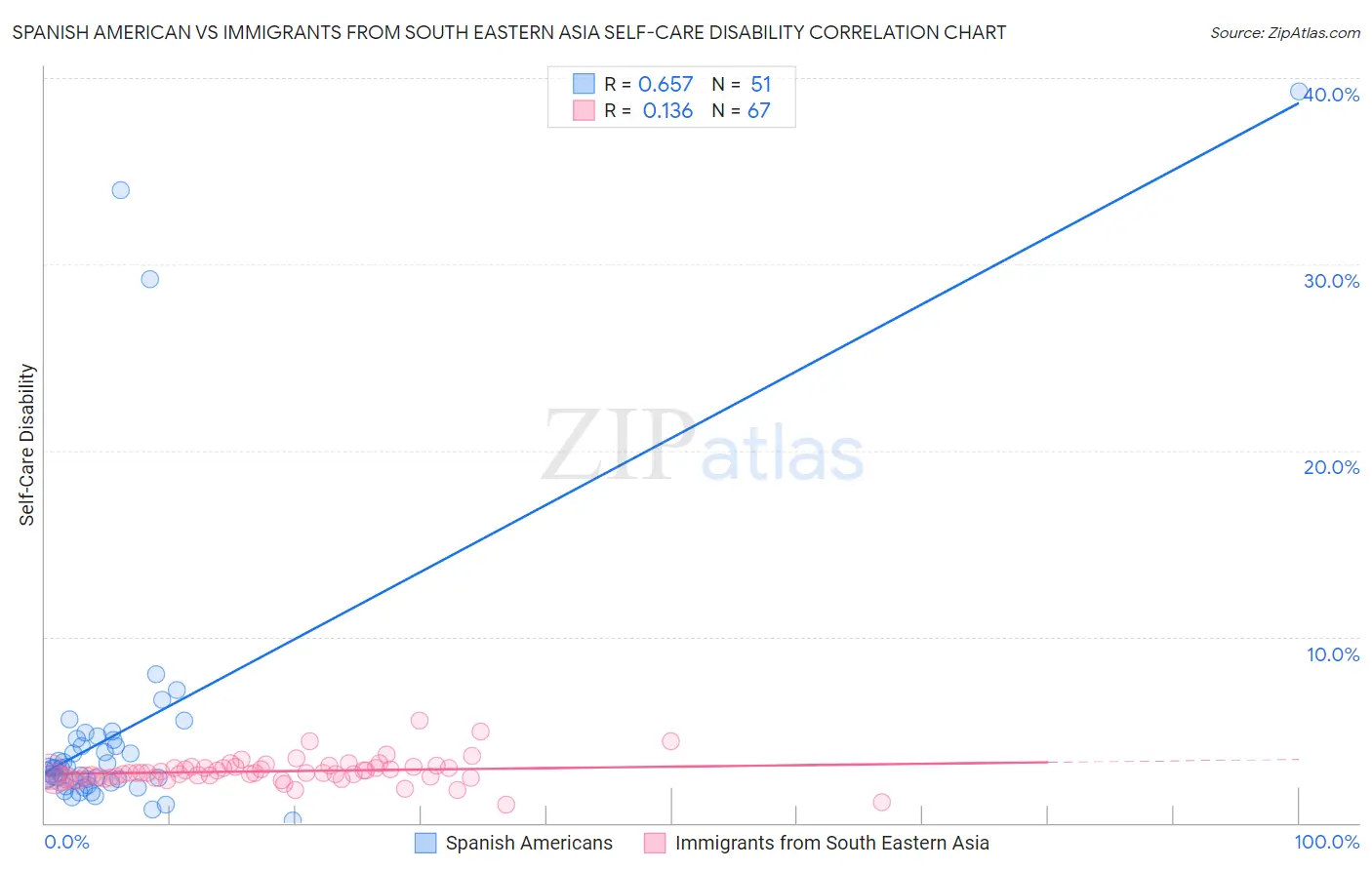Spanish American vs Immigrants from South Eastern Asia Self-Care Disability
COMPARE
Spanish American
Immigrants from South Eastern Asia
Self-Care Disability
Self-Care Disability Comparison
Spanish Americans
Immigrants from South Eastern Asia
2.8%
SELF-CARE DISABILITY
0.0/ 100
METRIC RATING
313th/ 347
METRIC RANK
2.5%
SELF-CARE DISABILITY
12.9/ 100
METRIC RATING
201st/ 347
METRIC RANK
Spanish American vs Immigrants from South Eastern Asia Self-Care Disability Correlation Chart
The statistical analysis conducted on geographies consisting of 103,142,959 people shows a significant positive correlation between the proportion of Spanish Americans and percentage of population with self-care disability in the United States with a correlation coefficient (R) of 0.657 and weighted average of 2.8%. Similarly, the statistical analysis conducted on geographies consisting of 511,565,632 people shows a poor positive correlation between the proportion of Immigrants from South Eastern Asia and percentage of population with self-care disability in the United States with a correlation coefficient (R) of 0.136 and weighted average of 2.5%, a difference of 12.2%.

Self-Care Disability Correlation Summary
| Measurement | Spanish American | Immigrants from South Eastern Asia |
| Minimum | 0.12% | 0.99% |
| Maximum | 39.3% | 5.5% |
| Range | 39.1% | 4.5% |
| Mean | 4.9% | 2.8% |
| Median | 2.9% | 2.7% |
| Interquartile 25% (IQ1) | 2.2% | 2.4% |
| Interquartile 75% (IQ3) | 4.4% | 3.0% |
| Interquartile Range (IQR) | 2.3% | 0.54% |
| Standard Deviation (Sample) | 7.6% | 0.71% |
| Standard Deviation (Population) | 7.5% | 0.70% |
Similar Demographics by Self-Care Disability
Demographics Similar to Spanish Americans by Self-Care Disability
In terms of self-care disability, the demographic groups most similar to Spanish Americans are Immigrants from Caribbean (2.8%, a difference of 0.030%), Creek (2.8%, a difference of 0.22%), Puget Sound Salish (2.8%, a difference of 0.23%), British West Indian (2.8%, a difference of 0.30%), and Bangladeshi (2.8%, a difference of 0.40%).
| Demographics | Rating | Rank | Self-Care Disability |
| Aleuts | 0.0 /100 | #306 | Tragic 2.8% |
| Natives/Alaskans | 0.0 /100 | #307 | Tragic 2.8% |
| Immigrants | Grenada | 0.0 /100 | #308 | Tragic 2.8% |
| Bangladeshis | 0.0 /100 | #309 | Tragic 2.8% |
| British West Indians | 0.0 /100 | #310 | Tragic 2.8% |
| Puget Sound Salish | 0.0 /100 | #311 | Tragic 2.8% |
| Immigrants | Caribbean | 0.0 /100 | #312 | Tragic 2.8% |
| Spanish Americans | 0.0 /100 | #313 | Tragic 2.8% |
| Creek | 0.0 /100 | #314 | Tragic 2.8% |
| Immigrants | Cuba | 0.0 /100 | #315 | Tragic 2.8% |
| Menominee | 0.0 /100 | #316 | Tragic 2.8% |
| Immigrants | Dominica | 0.0 /100 | #317 | Tragic 2.8% |
| Assyrians/Chaldeans/Syriacs | 0.0 /100 | #318 | Tragic 2.8% |
| Spanish American Indians | 0.0 /100 | #319 | Tragic 2.9% |
| Chickasaw | 0.0 /100 | #320 | Tragic 2.9% |
Demographics Similar to Immigrants from South Eastern Asia by Self-Care Disability
In terms of self-care disability, the demographic groups most similar to Immigrants from South Eastern Asia are Immigrants from Western Africa (2.5%, a difference of 0.030%), Slovak (2.5%, a difference of 0.030%), Immigrants from Lebanon (2.5%, a difference of 0.050%), Immigrants from Bahamas (2.5%, a difference of 0.11%), and Immigrants from Ghana (2.5%, a difference of 0.18%).
| Demographics | Rating | Rank | Self-Care Disability |
| Immigrants | Germany | 17.9 /100 | #194 | Poor 2.5% |
| Immigrants | Southern Europe | 15.6 /100 | #195 | Poor 2.5% |
| Koreans | 15.5 /100 | #196 | Poor 2.5% |
| Crow | 15.2 /100 | #197 | Poor 2.5% |
| Immigrants | Immigrants | 15.0 /100 | #198 | Poor 2.5% |
| Immigrants | Ghana | 14.7 /100 | #199 | Poor 2.5% |
| Immigrants | Western Africa | 13.3 /100 | #200 | Poor 2.5% |
| Immigrants | South Eastern Asia | 12.9 /100 | #201 | Poor 2.5% |
| Slovaks | 12.6 /100 | #202 | Poor 2.5% |
| Immigrants | Lebanon | 12.4 /100 | #203 | Poor 2.5% |
| Immigrants | Bahamas | 11.9 /100 | #204 | Poor 2.5% |
| Immigrants | Russia | 11.0 /100 | #205 | Poor 2.5% |
| Alaskan Athabascans | 10.4 /100 | #206 | Poor 2.5% |
| French | 9.9 /100 | #207 | Tragic 2.5% |
| Central Americans | 8.7 /100 | #208 | Tragic 2.5% |